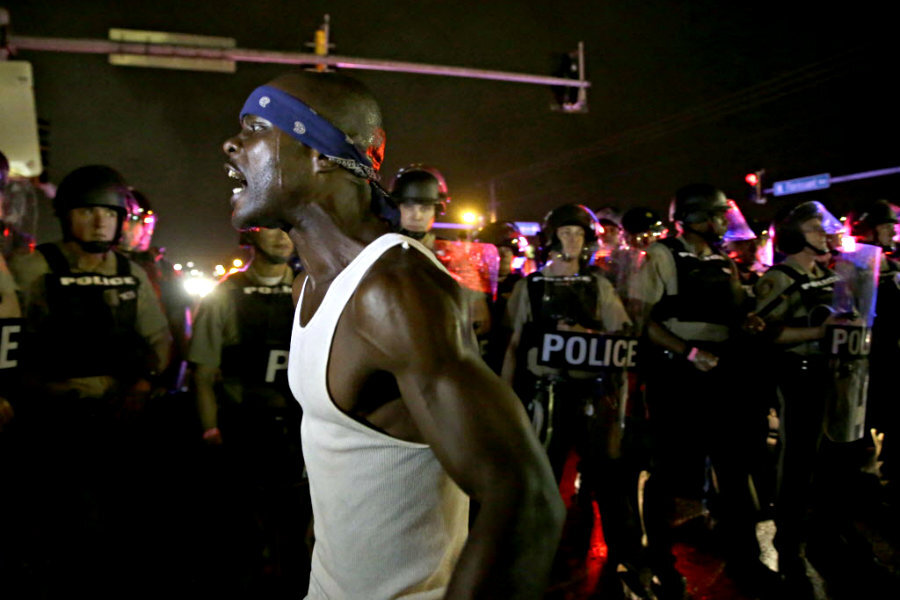Protest groups plan new rallies in Ferguson after night of violence
Loading...
Protest groups have criticized police response to demonstrators who gathered Sunday night to commemorate one year since Michael Brown’s death in Ferguson, Missouri. A new round of rallies, which organizers said were aimed at bringing attention to police violence against racial minorities, are being planned in and around the St. Louis suburb following Sunday’s events.
The anniversary of Mr. Brown’s killing – a shooting at the hands of a white Ferguson police officer that touched off a national debate around race and justice – sparked days of renewed demonstrations that until Sunday had been peaceful and without any arrests. But Sunday night grew violent, when – at the height of what was already a rowdy protest involving rocks and bottles being thrown at officers – gunshots rang out from the area near a strip of stores.
St. Louis County Chief Jon Belmar said it was important to distinguish between those who were exercising their right to protest in Ferguson and those involved in criminal activity, according to The Washington Post.
“There is a small group of people out there that are intent on making sure that we don't have peace that prevails,” Chief Belmar said. “That’s unfortunate. Because even with the folks who were in the street last night, there were a lot of emotions, I get it. But this is something different.”
The eruption of violence in Ferguson comes amid high tensions nationwide between law enforcement and the black community, and as confidence in police dips to its lowest in 22 years, a Gallup poll found in June.
“While the danger of the job hasn’t subsided, public admiration for police has dropped amid a string of video evidence showing police officers acting with seeming disregard for human life,” The Christian Science Monitor’s Patrik Jonsson wrote.
The Ferguson Action Council, a coalition of local protest organizations, said on Monday that the police should not have sent plainclothes officers without body cameras to an area where protests were being held, according to The New York Times.
“After a year of protest and conversation around police accountability, having plainclothes officers without body cameras and proper identification in the protest setting leaves us with only the officer’s account of the incident, which is clearly problematic,” Kayla Reed, a field organizer with the Organization for Black Struggle, said in a statement.
At a news conference early Monday, Belmar said feuding rival groups may have been the source of the gunfire. At one point, one man crossed the street, apparently spotted the plainclothes officers arriving in an unmarked van with red and blue police lights, and shot into the hood and windshield, Belmar said.
The officers fired back at the suspect, first from inside the van, then on foot when the suspect ran. The suspect again fired on the officers when he became trapped in a fenced-in area, the chief said, and all four officers fired back. He was struck and fell, and later taken to a hospital where Belmar said he was in "critical, unstable" condition.
Authorities didn't immediately release the identities of anyone involved. Tyrone Harris later said the injured suspect was his son, Tyrone Harris Jr., who was released from surgery early Monday, the St. Louis Post-Dispatch reported. The elder Harris' claim has not been confirmed.
None of the officers was seriously injured. All four have been put on standard administrative leave, Belmar said.
At the Fraternal Order of Police’s national conference in Pittsburgh on Monday, US Attorney General Loretta Lynch condemned “the violence against the community, including police officers, in Ferguson,” according to The Washington Post.
“As we have seen over the recent months and years, not only does violence obscure any message of peaceful protest, it places the community, as well as the officers who seek to protect it, in harm’s way,” Ms. Lynch said in a statement. “The weekend’s events were peaceful and promoted a message of reconciliation and healing. But incidents of violence, such as we saw last night, are contrary to both that message, along with everything that all of us, including this group, have worked to achieve over the past year.”
This report contains material from the Associated Press and Reuters.








